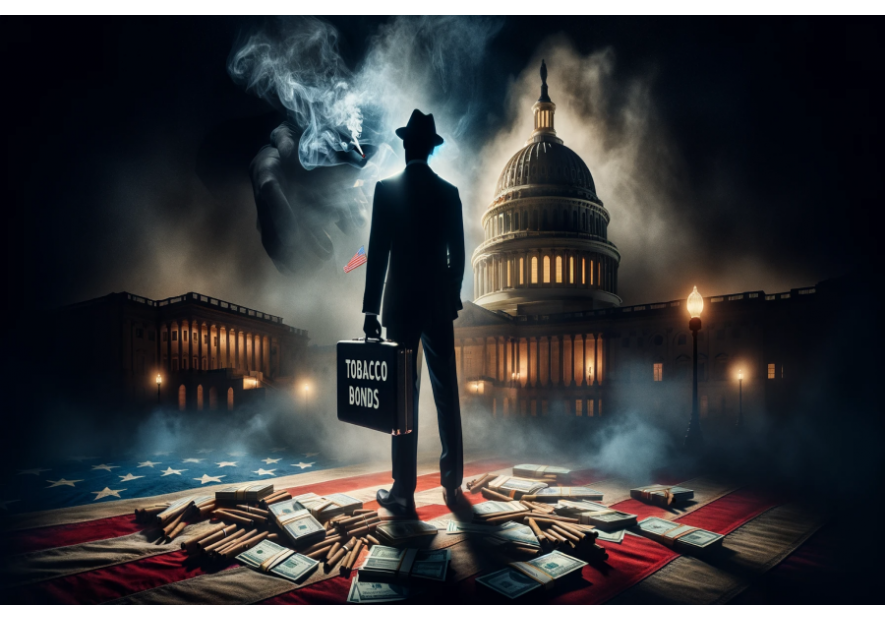A scandal made in the USA concerning the Tobacco Bonds

Why have several states in North America recently or better yet banned flavored E-liquid and banned vaping products?
A bit of history...
1950
Everything begins with Dr. Richard Doll. Indeed, he became the first to take an interest in the effects of tobacco on health.
After a few months of research, Doll published an article in the British Medical Journal. He was the first to demonstrate a link between smoking and cancer—a link known to everyone today, but which he was the first to prove through his research.
"What no one realized at the time was that tobacco contained weak carcinogens that required long-term exposure to have an effect," he explained a few years later.
1971
Back at his Zurich mansion after a day's work at the advertising agency bearing his name, Leo Burnett exchanged a few words with his wife before collapsing and dying of a heart attack.
Two months earlier, he was boasting about his exploits to various journalists, explaining the success and achievement of the Marlboro Man brand.
It was Burnett who advised Philip Morris in the '90s to "change the orientation" of a report linking cigarette smoke to lung cancer. Rather than explaining that secondhand smoke should be reduced, a memo suggested campaigning for "better ventilation."
1977
During this year, several executives of Philip Morris were interviewed by British television station Thames TV.
The documentary titled Death in the West, which retraced the story of five Americans (stereotypes of Marlboro Man) who all die of smoking-related diseases, included these interviews with PMI executives.
Before the presentation, the film was shown to Philip Morris's teams. Unhappy with the result and claiming to have been trapped, they sued the television station.
PMI won the lawsuit and banned the documentary's broadcast.
The same year, the seven biggest leaders in the tobacco industry gathered following a call from Tony Garrett, President of Imperial Tobacco.
All seated around a round table, they were there to, in their own words:
"Develop a defensive strategy on smoking and health, to prevent our countries and/or companies from being eliminated one by one, with the resulting domino effect."
The tobacco resistance organized and was named Operation Berkshire.
From that day forward, the tobacco industry would not merely shrug off the increasing evidence that tobacco is harmful but would seek to suppress this evidence or at least combat it.
For instance, by creating the Center for Indoor Air Research: a research unit composed of high-ranking individuals, intended to "maintain controversy" regarding the harmful effects of secondhand smoke.
INFOTAB was also designed to monitor anti-smoking organizations, "make allies" and refute data from the anti-smoking lobby.
1997: Creation of the Tobacco Master Settlement Agreement
Over all the aforementioned years, more than 800 private complaints were filed against the tobacco industry. Every lawsuit, without exception, was won by the defendants. The tobacco industry, with unlimited funds, always found a way to win the numerous lawsuits against it.
However, that year, thousands of lawyers were present, and a significant conference was held at the ANA Hotel in Washington. A historic day. After a lengthy trial in which 46 states united against the tobacco industry, the latter folded.
This victory takes the form of an agreement signed in November 1998, the Tobacco Master Settlement Agreement (MSA).
It commits the tobacco industry (Philip Morris, Inc., R. J. Reynolds Tobacco Company, Brown & Williamson Tobacco Corporation, and Lorillard Tobacco Company, collectively referred to as the Original Participating Manufacturers) to pay 368.5 billion dollars to 46 states over the next 25 years. This money is intended to "cover the medical costs related to smoking-related diseases".
Champagne glasses clink together, the victory is total, Big Tobacco is defeated, legally at least.
However, despite this defeat, the tobacco industry doesn't seem really affected by the news.
It must be said that despite the significant sum disbursed, it represents, in the end, only 2% of the companies' turnover over the next 25 years.
In comparison, it's like a person earning 2000 euros per month having to pay a fine of 40 euros.
Furthermore, the signed agreement doesn't prevent the sale of cigarettes, there are just a few advertising restrictions. Moreover, the tobacco industry made sure to send a message in the agreement: it will no longer be sued for past damages.
2008: The tobacco industry continues its resistance
Ten years after the signing of the MSA, things have hardly changed.
Tobacco continues to kill. Nearly 6 million people die from it each year. On average, one in two smokers dies from a smoking-related disease.
The tobacco industry, although it had to sign the MSA agreement, continues its activities and makes profits.
But that year, a new threat emerged: the electronic cigarette.
For the first time in a long time, the number of smokers in the world is decreasing, mainly thanks to this new invention.
The e-cigarette does not produce smoke, only steam. It doesn't contain tar or carbon monoxide, and it allows one to control nicotine consumption.
For the tobacco industry, it's a disaster.
The industry then decides to counter-attack. By investing massively in vaping, it intends to keep a grip on nicotine consumers.
By 2018, most major tobacco companies have their own brand of electronic cigarettes.
But that's not enough. If smokers switch to electronic cigarettes, the tobacco industry's profits will drop. So, something needs to be done.
Vaping in the Spotlight
In 2019, an event will allow the tobacco industry to launch an offensive against vaping.
A mysterious respiratory disease strikes many vapers in the United States. The media seize the story and talk about a "vaping epidemic".
Quickly, it appears that the sick are mostly consumers of vaped THC (the active ingredient in cannabis), not nicotine.
Moreover, it turns out that most of these products were sold on the black market and contained vitamin E acetate, a harmful substance when inhaled.
Despite these elements, fear of vaping is instilled in people's minds. The tobacco industry sees this as an opportunity to seize.
Ban on Flavored E-Liquids
In September 2019, the governor of New York State, Andrew Cuomo, announces a ban on flavored e-liquids.
The reason given is youth protection. According to him, the fruity or gourmet flavors of e-liquids attract teenagers and encourage them to vape.
The tobacco industry rubs its hands together. Not only has it managed to sow fear of vaping, but it has also obtained a ban on most e-liquids, thus reducing the appeal of the electronic cigarette.
In the months that follow, several other U.S. states announce bans on flavored e-liquids in turn.
The tobacco industry can rejoice. Its strategy has worked. It has managed to slow the rise of vaping and preserve its profits.
But at what cost? How many smokers, who could have switched to the electronic cigarette and thus reduced their risk of disease, will continue to smoke tobacco because of these bans?
The story of tobacco and vaping is a story of power and money. But it's above all a story of public health. And in this story, it seems that citizens' health has been sacrificed on the altar of the tobacco industry's profits.
